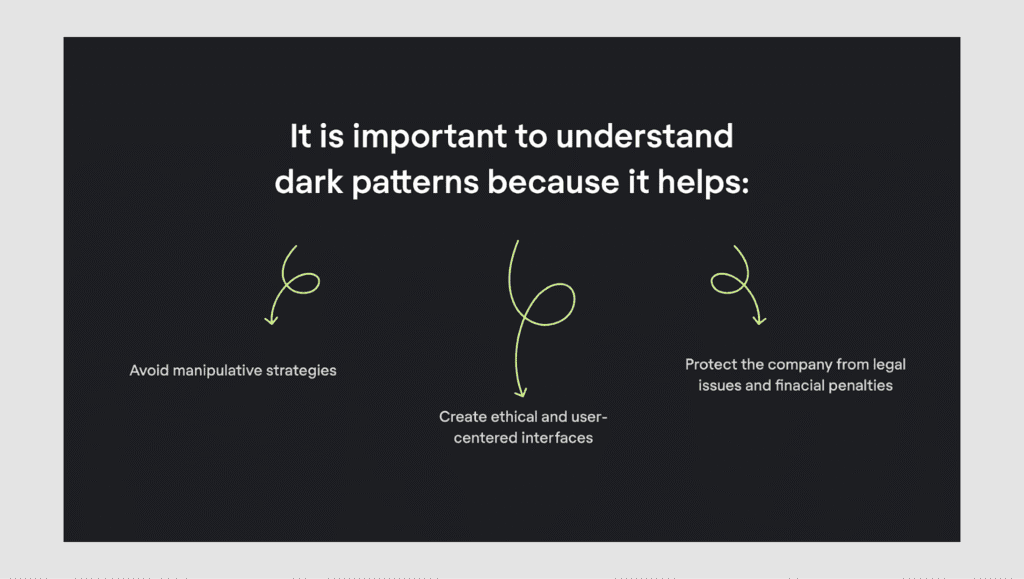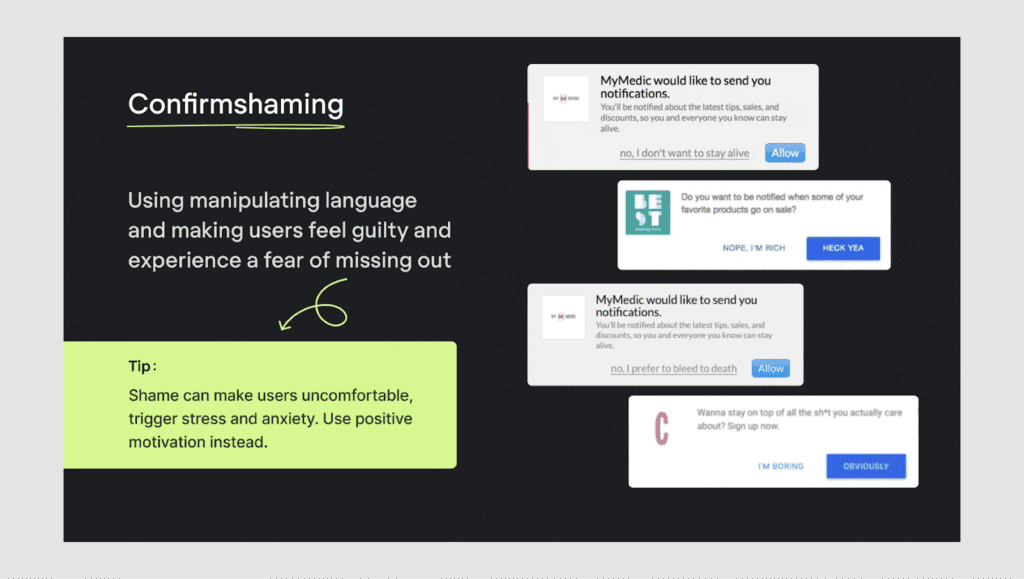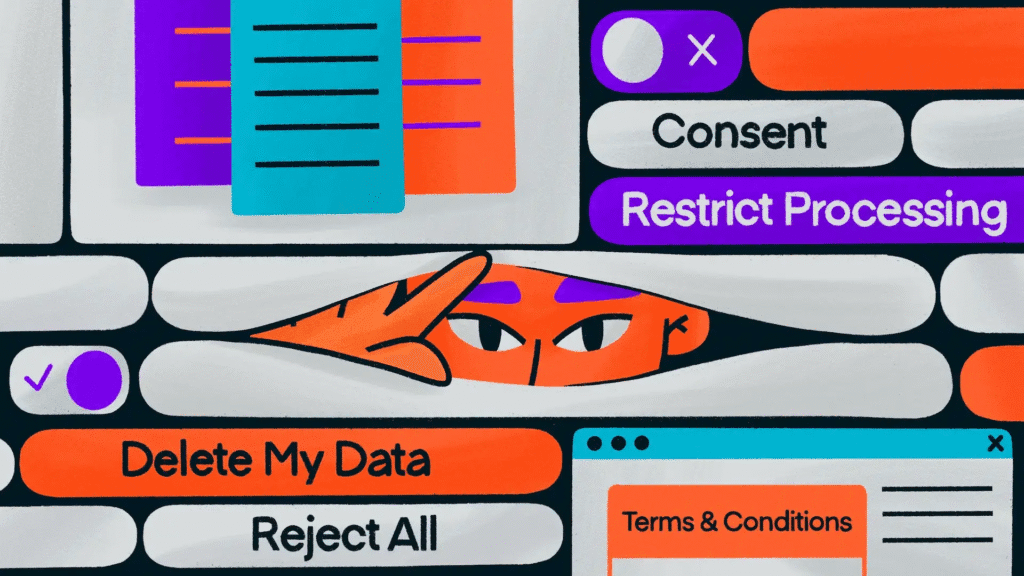Dark Patterns UX: The revolution of digital payment systems, quick loan requests, is a fact that has changed the face of the financial situation in India. Whether it is the constant QR code scanning done by PayTM and PhonePe or even blazing-fast payouts provided by different credit apps, fintech has become a synonym of extraordinary convenience to millions of people. But, behind this facade of effectiveness, there is a hidden threat that subtly undermines user confidence and, worse still, user wallets: “dark UX.” Think of filling your mobile phone with 100 with the receipt only to find that 85 is all that was added to your account.
Table of Contents
Dark Patterns UX Scheme
All the 15 rupees that were missing did not represent a network snafu; it had been carefully drained out by an add-on auto-insurance plan you never read or voluntarily agreed to, selected in advance by someone who knew it was not one of the most well-understood auto-insurance plans. The real-life, infuriating situation may serve as the classic use of dark UX at work – malicious design patterns created to make the user perform the action that they did not desire to do, most of the time leading to loss of finances or violation of privacy.
It is also with the purpose of shedding light on these malicious design strategies so common in the Indian fintech sector, to help inform the people about the insidious nature of these tricks, and people are informed to act in order to avoid being one of the many that succumb to these digital deceits.
What is Dark UX?

Dark UX or more commonly known in the industry as Dark Patterns are user-interface designs that are employed in websites and applications and primarily made to deceive, trick or coerce users into making decisions that are not necessarily advantageous to them. Contrary to, say, sins of simple design flaws, the dark patterns are intentional and are laid out to serve the service provider, often at the cost of the user (usually in money, time, or with less privacy). Such manipulative designs are used to take advantage of human psychology and capitalize on mental biases, time pressure, and the lack of user attention to accomplish their goals.
Types of Dark Patterns UX
There are also many types of dark patterns identified and characterized all over the world. An example of this is so-called “ConfirmShaming”, which is actually an effort to make a user feel guilty to agree to something by making the opposite choice negative (e.g. “No thanks, I do not want to save money”).
- Bait and Switch: It refers to a situation where there is marketing where the user is sold something and after committing to it, something different and of lower quality is delivered. This is also the “Roach Motel” effect in that is is incredibly easy to get into a situation (e.g., sign-up a subscription) but infamously difficult to get out of it (cancelling the subscription). Another set of frequently applied patterns is called the topics of Hidden Costs (imposing surprise charges at the checkout) and Misdirection (getting customers distracted by unessential information).
Risk on Consumers Due to Dark Patterns

The popularization of dark patterns as a vital issue affecting consumer protection is on the rise all across the globe. The U.S. Federal Trade Commission (FTC) has warned and taken to court businesses that use misleading designs and the significance of straight-forward and open-ended user interfaces. European Union, the forerunner of digital rights, has baked particular measures of the manipulative design into its strong Digital Services Act (DSA) where the centrality of user autonomy and informed consent have taken precedent.
Although in India, a direct, broad regulation to deal precisely with the dark UX remains in stages of development, the Digital Personal Data Protection (DPDP) Act, 2023 is most relevant since its recent adoption. The focus on explicit consent to processing of data and the right to withdraw consent found in this act implicitly contest most of the dark patterns, especially the ones associated with forced consent and exploitation of data.
Nevertheless, the clear enforcement and interpretation of the given patterns related to the UX are still at the initial stages.
Dark Patterns in Indian Fintech

Competitive nature with the user acquisition race and high stakes in the Indian fintech environment has turned out to be the spawning ground of many dark patterns UX though. The tactics may seem small but they add up to vast amounts of financial and privacy hazard towards an unwary user.
| Pattern Type | Example (Hypothetical) | Impact on Users |
| Hidden Charges | An app offering mobile recharges auto-selects a “personal accident insurance” add-on for ₹15 without a clear opt-out. | You lose money unintentionally. The charge is often minuscule enough to be overlooked in the total transaction, accumulating over multiple recharges. |
| Forced Consent | During app onboarding, a pre-checked box states, “I agree to receive promotional messages and partner offers.” | Your data is sold or shared without explicit permission. This leads to an influx of unsolicited marketing calls, SMS, and emails, compromising privacy. |
| Tricky CTA Buttons | On a loan application, the “Submit Application” button is large and green, while “Cancel” or “Not Now” is tiny, grey, and difficult to spot at the bottom. | You click without noticing or intending to. Users are subtly nudged towards irreversible actions, like applying for a loan, before they are fully ready. |
| Fake Urgency | A lending app displays a countdown timer: “Your pre-approved loan offer expires in 2 minutes!” accompanied by a flashing alert. | Users panic and convert quickly. This artificial pressure forces hurried decisions, often leading to acceptance of unfavorable loan terms due to fear of missing out. |
| Roach Motel | Subscribing to a premium feature on a payment app is a single tap, but cancelling requires navigating through multiple menus, filling out forms, or calling customer support. | You stay stuck in subscriptions. Users are trapped into recurring payments for services they no longer desire, leading to continuous, unwanted deductions. |
- Hidden Fees: It is possibly one of the most prominent dark patterns. Lots of fintech apps offer inconspicuous extra features that come by default. An example can be attributed to circumstances where you are charging your phone or giving an insurance cover where there is a minuscule, pre-ticked button that says, either to give out to charity as opposed to say your personal accident cover, that is right at the bottom of the screen.
Consumers Forced to Consent Due to Dark Patterns UX

The client who was being concerned with the main transaction pays money, and after some time finds out that some additional money was charged as payment to a service that was not wanted or agreed to. Such minor deductions accumulate after a long period of time affecting a user and his/her finances without him/her being aware of it.
- Forced Consent: Data is the new oil and numerous fintech applications are developed in such a way to harvest as much data as possible. In the first sign-up or onboarding process, users often encounter so-called check boxes, which have been ticked by default, and inform about giving consent to such aspects as “getting notification of promotional content,” or “giving and distributing data to third-party partners,” or even “individualization of offers.”
They do not deserve much attention, and users eager to see the main features of the app do not pay much attention to these pre-selected variants as they can easily give consent to use their personal data in advertising purposes, sell them to aggregators, etc. This interferes with privacy and incurs floods of unwanted messages.
- Slimy CTA Buttons: Call-to-Action (CTA) buttons influence the user behavior in a significant way, which is why they are designed in an appealing way to captivate the user. This aspect of human behavior is used by Dark UX where the positive outcome (e.g., “Proceed with loan”, “Subscribe now”) is large, bold, and easy to find, but the alternative, negative option (e.g. “Cancel”, “Decline”, “Not now”) is small, greyed out, or simply invisible.
This unethical design causes users to automatically tend to click on the button that is more obvious and usually do something they did not have in mind when they do it.
- Fake Urgency: Causing a fake sense of urgency is another old dark pattern that is most abundant in instant loan and investment applications. The barrage of notifications bombarding the users include things like “Your pre-approved credit offer expires in 5 minutes!” or “Once-in-a-lifetime investment, take action now to get in on 10% rates!”
These strategies set in motion the fear of missing out (FOMO) and bypass rational decision making. The incident can cause panic among the users who end up accepting high interest loans or risky investment plans without closely scrutinizing the terms and conditions in place which quite often pose financial risks.
- Roach Motel: This trend explains a possibility whereby it is too much of ease to join a commitment but so much challenge to get out of the commitment. Most of premium trials or subscriptions in fintech applications provide one tap-subscription mechanism.
Yet, when the customer wants to get rid of the usage, he or she cannot just turn it off, because he has to go through confusing menus, arcane settings, complete prodigious forms, or even call the customer support to certain hours. This design friction makes sure that some portion of the people abandon the cancellation process, leaving them stagnated with repeat fees that they do not wish and need, on services they have ceased to make use of.
Why Dark Pattern Use is Legal?

The ubiquity of dark UX patterns in India can even leave users with a question of why such practices that appear so unethical are not illegal in the first place. This is mainly because there is a huge gap in regulations. However, unlike the strong Digital Services Act (DSA) as established in the European Union that explicitly mentions manipulative design patterns and explicitly states they are not to be implemented or used, India does not have particular legislation focusing on the design of digital platforms, interfaces, deceptive designs and interfaces, and other practices.
How These Patterns Take Advantage?
Most dark patterns take advantage of the legal grey areas of the current laws or have a grey character where unethical and illegal reside. As an example the company may have officially listed an unseen charge somewhere in a excessive terms and conditions document that no human is realistically going to read and the company may claim informed consent. Equally, a checked box to allow data sharing, although highly unethical, may not necessarily go against the current regulations and existing laws of data protection in case the user technically abides by the option by clicking on it.
Misuse of Data Protection Act in India
Although the Digital Personal Data Protection Act, 2023 (DPDP Act), is a crucial shift in line with protecting the user data and privacy in India, its actual enforcement when applied to particular dark UX patterns is yet to be outlined and experimented on. The DPDP Act states that data procession must be done with clear consents by the consenting authority that is informed and not ambiguous. In theory, this principle can be used to question such practices as ineluctable compliance with checked boxes. Nevertheless, the burden is usually on the individual user to prove that such consent was not indeed “informed”, which is proving to be a huge obstacle.
Moreover, the act is not concerned with the whole range of manipulative design, which generates financial loss or other unwanted behaviors as its ultimate goal. Its deployment and its transformation to dark patterns will be pivotal yet at their early phase and thus the implementation in its efficient application will be restricted in the short-term basis. Succinct and strict laws will have to be implemented and strictly followed before a large number of dark patterns can be eliminated hiding in the grey zones of legality.
How to Avoid Dark Patterns

In the meantime, until the regulatory framework catches up, there is no complete loss of recourse on the part of users. One of the best ways to avoid becoming a victim of the ill-fated dark UX is to empower oneself with knowledge and develop careful digital behaviors.
- Always read small text and uncheck defaults: The most essential protection. Small text, disclaimers, pre-selected options: Read carefully before clicking a button to “Accept,” to “Proceed” or to make a monetary payment through a button that says “Pay.” In order to do this, never check the boxes which are pre-ticked, particularly those boxes which are marketing or third party information and so on.
- Dummy Email/Number: When you don’t have absolute confidence in the app, such as when trying something out or the app is especially pushy about access to a lot of your information, use secondary or dummy email addresses (or other permissions that can have email addresses associated with them) and a secondary/dummy phone number (if you can obtain them). This can serve to reduce the number of spam messages and make sure that your main contact information is not virally spread by diverse people.
- Watch Out For Ugly Urgency Techniques: When an app or a site makes you feel pressured by saying there are only a few minutes left, or that the offer is time limited, take a breather. These are the tricks mostly used to be manipulative. Never rush into making any financial decisions because you have the offer and you need to be able to read the terms and take your time to process the decision.
- Check Permissions With Care: Pay attention to permissions that new app requests when they are installed. Even an app that offers payment services has probably got no business accessing your contacts in order to enable peer-to-peer even payment, but why does it insist on accessing your microphone or photo gallery(,) unless you are using that particular feature? Give only the necessary accesses.
- Monitor Bank Statements and App Transaction History: It is important to note that you can check the bank statements and app transaction history on a regular basis to be aware of any possible risks. This will enable you to realize any deduction that is not legal or unforeseen in a short time hence taking the necessary captive.
- Report to NPCI / RBI in case of Money loss: When you have any suspicion that you may have been victimized or lost money due to deceit and you need to report. In matters of UPI transactions or any other payment related to digital money, the concerned authority is the National Payments Corporation of India (NPCI). The Reserve Bank of India (RBI) has allocated an exclusive web portal to offer consumers a wider platform of complaint against the banks or other financial institutions that are regulated by the Reserve Bank.
- Link: RBI Consumer Complaints Portal: https://cms.rbi.org.in/ (Users can lodge complaints against various regulated entities here).
The Future of the Current State of UX regulation in India
The present situation that is characterized by the widespread success of the phenomenon of the dark UX in the context of the absence of control in the form of explicitly formulated and comprehensive regulations, therefore, highlights the necessity of a healthier framework in India. The next stage of UX regulation is to shift toward complete proactive action, to the protection of the safety of users and encourage ethics of designing process.
Proposed Government Regulations:
Specific Legislation Addressing Digital Design Ethics: India should look to enacting the legally-binding versions of what the Digital Services Act is implementing in parts of the EU, which are designed to help define and outlaw many dark patterns. This would place a clear legal ground to mistreat the businesses that deliberately deceived the users with the applications of interface design.
Simple Disclosures: It should be a requirement that a regulation should have clear, obvious and simple disclosure to all the charges, subscriptions and data-sharing agreements. Check boxes that are already checked must be illegalized on issues that are costly or give personal information.
Minimized Opt-Out and Cancellation Opt-Out and cancellation areas have to also be simplified and fast so that they should be as easy as the signups. The cancellation of subscriptions or the withdrawal of consent should be as frictionless and easy as possible.
Standardized Consent Frameworks: standardized frameworks of acquiring consent to the sharing of data and agreements to the services could be established by the government, perhaps within the Ministry of Electronics and Information Technology (MeitY) or a specific digital regulator, and this will make it simpler to users to comprehend and control their authorization.
Consequences of Non-Compliance: heavy fines, relating to the revenue of the violating company are mandatory deterrence measures. To discourage the use of dark patterns, these penalties must not only be conceived as a way to obtain damages but also as ways to deter such consumer behaviors.
The Ethical Design Movements and Their Functions:
A better digital future as to be more responsible and sustainable is outlined by the growth of ethical design movements worldwide, the success story of which is represented by organizations like ethical design guide. These movements believe in such principles as:
- Transparency: Tell the users what is going on, in a clear and open way.
- User Autonomy: Design should not manipulate a user into making a decision, it should empower them with information, where informed choices are made.
- Privacy by Design: Build privacy into the design by taking it into account at the most fundamental level of design.
- Accessibility: Make designs accessible and comprehensible to everyone including deaf people.
These values are a possible guideline to future regulatory principles in India and which can create an atmosphere in which ethical design is not an exception, but a rule.
RBI/NPCI Fintech Framework Potential Updates:
Considering that they exercise regulatory control over the financial ecosystem, the RBI and NPCI can afford particular opportunities to modernize the current fintech systems to deal with dark UX.
- Licensing/Compliance Requirement: New licensing and requirements imposed on fintech app may consist of the strict observance of the ethical principles of the UX design and the review of users interfaces on a regular basis.
- Consumer Protection Guidelines: The RBI can issue guidelines specifically on its consumer protection policies to state that dark patterns are banned in financial products, and what design would fall under the ban due to being deceptive.
- Dispute Resolution Mechanism: More effective and faster dispute resolution mechanisms would be provided to users, who have become the victims of dark patterns, and financially compensate them to recover the money lost.
- User Awareness Campaigns: Providing broad based user awareness creation regarding dark patterns and their detection and prevention strategies akin to the ones that already exist regarding cybersecurity and fraud prevention.
Growth of Dark UX Patterns
This growth of dark UX patterns has been insidious at best and unethical at worst in Indian fintech applications, with a clear financial loss to consumers as well as a loss of faith in the system one seemingly inoffensive click at a time. The false promises of hidden fees that slowly deplete wallets or even manipulative design of interfaces that tricks people into unwilling consent, these deceptive design takes advantage of the cognitive weaknesses and uncertainty of regulations. Although the ease of digital categories is undeniable, such as PayTM, PhonePe, instant loan apps, this should not affect the freedom and economic security of the user.
The article has attempted to shed light on what dark UX encompasses, the frequent manner in which it has been practised within the Indian market in the fintech space, and just how serious this situation requires the attention of strong regulatory action. Effective first-line defenses include user vigilance in terms of reading carefully, un-checking defaults, and reporting suspected activity. Nevertheless, systemic change across long-term will require active government involvement better government legislation, enforcing the laws meant to protect data (such as DPDP Act), and newer fintech frameworks by regulatory authorities such as the RBI and the NPCI.
Steps to End Dark Patterns UX
In the end, it is of utmost importance to achieve an ethical digital environment that will be based on design, benefiting the user, and not manipulating them. With increased awareness, responsible behavior, and action, a positive change towards the responsible design practices alongside increased accountability of providers of digital services, we will be able to ensure the future of Indian fintech is constructed on the principles of transparency, trust, and true human empowerment.
Call to Action: Send this article to a person that uses UPI on a regular basis. The knowledge might be the thing that would prevent them to fall into these digital traps.
References
Harry Brignull, Dark Patterns (2010).
Harry Brignull, Dark Patterns (2010), https://hdl.handle.net/1721.1/151423.
Arunesh Mathur et al., Dark Patterns at Scale: Findings from a Crawl of 11K Shopping Websites, Proceedings of the ACM on Human-Computer Interaction 3, CSCW (2019), https://pure.psu.edu/en/publications/the-darkpatterns-side-of-ux-design.
Federal Trade Commission, A Review of Subscription Traps and Deceptive Free Trials (2018), https://pure.psu.edu/en/publications/the-dark-patterns-side-of-ux-design.
Colin M. Gray et al., The Dark (Patterns) Side of UX Design, CHI Conference on Human Factors in Computing Systems Proceedings (2018), https://pure.psu.edu/en/publications/the-dark-patterns-side-of-ux-design.
Robert B. Cialdini, Influence: The Psychology of Persuasion (2006), https://www.amazon.in/Evil-DesignInteraction-Lead-Temptation/dp/1118422147.
Chris Nodder, Evil by Design: Interaction Design to Lead Us into Temptation (2013), https://www.amazon.in/Evil-Design-Interaction-Lead-Temptation/dp/1118422147.
“Analysis of Information Technology Act, 2000 with Respect to Data Protection,” Indian Journal of Law and Technology, 2018, https://vidhilegalpolicy.in/wp-content/uploads/2021/06/IJLT-Vol-161.pdf.
Information Technology Act, 2000, s. 43A, s. 72A, Ministry of Electronics and Information Technology, Government of India. Available at: https://www.meity.gov.in/content/information-technology-act-2000.
Ministry of Consumer Affairs, Food and Public Distribution, Government of India, “Consumer Protection Act, 2019 – An Overview,” 2019. Available at: https://consumeraffairs.nic.in/consumer-protection-act-2019-overview.
Consumer Protection Act, 2019, s. 2(47), s. 17(2), Ministry of Consumer Affairs, Food and Public Distribution, Government of India. Available at: https://consumeraffairs.nic.in/acts-and-rules/consumer-protection.
Legal Commentary on Consumer Protection Act, 2019, “Unfair Trade Practices under the New Consumer Protection Act,” International Journal on Consumer Law and Practice, National Law School of India University, Bengaluru, 2020, https://repository.nls.ac.in/ijclp/vol8/iss1/2/.
Digital Personal Data Protection Act, 2023, s. 11, s. 12, Ministry of Electronics and Information Technology, Government of India. Available at: https://www.meity.gov.in/dpdp-act-text.
“Empowering Users: The Right to Withdraw Consent in DPDP Act,” Department of Electronics and Information Technology, Government of India, 2023. Available at: https://www.meity.gov.in/dpdp-act-overview.
Digital Personal Data Protection Act, 2023, s. 4, Ministry of Electronics and Information Technology, Government of India. Available at: https://www.meity.gov.in/dpdp-act-text.
“Digital Personal Data Protection Act, 2023: Ensuring Clear and Informed Consent,” India Corporate Law Blog, Cyril Amarchand Mangaldas, September 2023. Available at: https://corporate.cyrilamarchandblogs.com/2023/09/digital-personal-data-protection-act-2023-overview-andimplications/.
Central Consumer Protection Authority, “Draft Guidelines for Prevention and Regulation of Dark Patterns, 2023,” Ministry of Consumer Affairs, Food and Public Distribution, Government of India, 2023. URL: https://consumeraffairs.nic.in/latestnews/draft-guidelines-prevention-and-regulation-dark-patterns-2023.
Draft Guidelines for Prevention and Regulation of Dark Patterns, 2023, s. 2(e), Central Consumer Protection Authority of India, https://consumeraffairs.nic.in/sites/default/files/file-uploads/latestnews/Draft%20Guidelines%20for%20Prevention%20and%20Regulation%20of%20Dark%20Patte rns%202023.pdf/.
Internet and Mobile Association of India & Kantar, Internet in India Report 2022 (2023). URL: https://www.mxmindia.com/media/759-mn-indians-active-internet-users-to-reach-900-mn-by-2025-iamaikantar/.
European Union’s General Data Protection Regulation (GDPR), Regulation (EU) 2016/679. Available at: https://eur-lex.europa.eu/eli/reg/2016/679/oj.
Commission Nationale de l’Informatique et des Libertés (CNIL), “GDPR: CNIL’s Stance on Consent and Dark Patterns,” 2019. Available at: https://www.cnil.fr/en/home.
European Data Protection Board (EDPB), “Consultation on Guidelines for Social Media and Dark Patterns under GDPR,” 2021. Available at: https://edpb.europa.eu/our-work-tools/our-documents_en.
U.S. Federal Trade Commission, “FTC Complaint against Age of Learning, Inc. (ABC Mouse),” 2020. Available at: https://www.ftc.gov/news-events/news/press-releases/2020/09/ftc-alleges-company-behindabcmouse-deceived-consumers.
Rohit Chopra, Statement of Commissioner Rohit Chopra Regarding Dark Patterns in the Matter of Age of Learning Inc., Commission File Number 1723186 (Fed. Trade Comm’n Sept. 2, 2020), https://www.ftc.gov/system/files/documents/public_statements/1579927/172_3086_abcmouse_- _rchopra_statement.pdf.
Deceptive Experiences to Online Users Reduction (DETOUR) Act, S. 1084, 116th Cong. (2019). Available at: https://www.congress.gov/bill/116th-congress/senate-bill/1084/text.
Setting an American Framework to Ensure Data Access, Transparency, and Accountability (SAFE DATA) Act, S. 2330, 116th Cong. (2019). Available at: https://www.congress.gov/bill/116th-congress/senate-bill/2330/text.
California Privacy Rights Act (CPRA), Cal. Civ. Code § 1798.100 et seq. Available at: https://oag.ca.gov/privacy/ccpa.
Colorado Privacy Act (CPA), C.R.S. § 6-1-1303. Available at: https://leg.colorado.gov/bills/sb21-190.
Dattopant Thengadi National Board for Workers Education & Development, Ministry of Labour & Employment, Govt. of India, Digital Literacy (2023). Available at: https://dtnbwed.cbwe.gov.in/images/upload/Digital-Literacy 3ZNK.pdf.
For more updates follow: Latest News on NEWZZY

